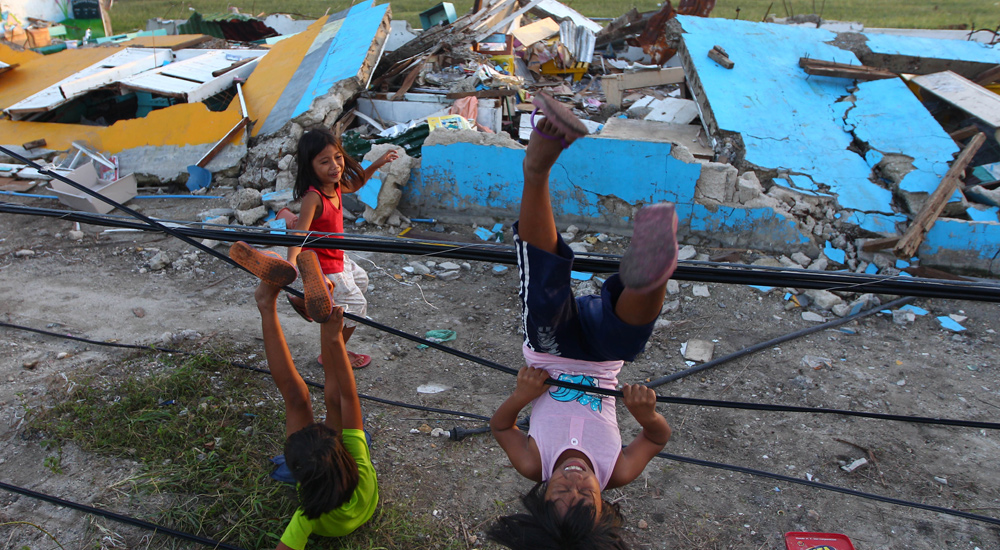Resumption of classes still uncertain

Young survivors of Typhoon Haiyan play with fallen power lines near a damaged school in Guiuan, Philippines, Thursday, Nov. 14, 2013. Typhoon Haiyan, one of the most powerful storms on record, hit the country’s eastern seaboard on Friday, destroying tens of thousands of buildings and displacing at least a half-million people. (AP Photo/Dita Alangkara)
CARLES, Iloilo—Sixteen-year-old April Joy Juarez lost her house when two coconut trees uprooted by Supertyphoon “Yolanda” fell on the seaside structure on Nov. 8. Most of her family’s belongings were washed away by huge waves at the height of the storm.
Luckily, the family had evacuated to the nearby Bangcal Elementary School in the coastal village of Bangcal the day before.
April Joy, a senior student of Balasan National High School, was able to save her prized belongings, including a bag she kept inside a cabinet at the principal’s office. The bag contains books, notebooks and other school materials.
“I hope I can go to school again soon,” she told the Inquirer on Friday at the school where about 30 evacuees were staying.
Classes for many elementary and high school students will not resume soon in Western Visayas, especially in areas worst hit by the typhoon in northern Iloilo, northern
Article continues after this advertisementAntique, Capiz and Aklan.
Article continues after this advertisementOfficials of the Department of Education (DepEd) were still gathering reports of damage to schools. In Iloilo alone, at least 1,200 classrooms were destroyed and 1,000 others damaged, according to John Arnold Siena, officer-in-charge of the DepEd regional office.
Many schools are serving as evacuation centers for tens of thousands of people.
Teachers lost homes, too
Siena said school officials were given a leeway in deciding when to resume classes, taking into account the extent of damage to school buildings and availability of alternative classrooms.
“We have to consider that teachers also lost their homes and are taking care of their families. It would be difficult for them to focus on teaching their students,” he said.
School officials have been directed to meet with local government officials and community leaders to find ways for the earliest resumption of classes. They will also assess the readiness of families to send their children to school.
In Passi City in Iloilo, only 10 percent of the students showed up in schools on Thursday, six days after Yolanda.
In Carles, almost all classrooms had their roofs blown away. Many schools have shattered windows and collapsed walls.
With most structures in ruins, it would be difficult to find alternative classrooms, said municipal administrator Ma. Pofe Esmilla.
“Before, we could say that we can hold classes under the mango tree if we lack classrooms. But we have no (standing) trees left,” Esmilla said.
Carles, a coastal municipality in the northeastern tip of Panay
Island and 146 kilometers from Iloilo City, was among the worst hit by the typhoon. Eighteen of the 33 villages bore the heaviest damage, said Mayor Arnold Betita.
Forty-eight have been reported dead, the second biggest number of fatalities in Western Visayas after Estancia town, also in Iloilo, which had 86 as of Sunday.
Most of Carles, a rich fishing ground and known for its idyllic islands with white beaches, are in ruins.
Esmilla said the typhoon destroyed 4,653 houses and damaged 4,918 others. Fishponds were leveled and most fishing boats were wrecked.
Another classroom
At Bangcal Elementary School, the evacuees still recall the horror during the onslaught of the typhoon.
“We thought we were safe here but we had to transfer to
another classroom and cover our heads with pieces of plywood because the ceiling was falling,” said April Joy’s mother Gina, 40.
Her husband, Luderito, a crew member of a fishing boat, is putting up a shanty dwelling, but Gina is worried more on how to feed their children and their continued education.
The family has been surviving on relief assistance since Sunday. They have to line up for three hours to get their share of goods at the barangay (village) distribution center.
Many other survivors are relying on help from relatives in other provinces. At the municipal center, about 30 residents have swamped a money transfer outlet.
“We will make do and try to rise again,” Gina said.
April Joy said her classmates had told her that classes could resume in January and might be extended till May. If ever she graduates next year, she wants to enroll in a business administration course. “I want to work in a bank or put up a small business,” she said.
As night fell at the evacuation center, Yolanda’s destruction was hidden amid the laughter of children still playing on the school ground.
Two of the children holding pillows over their heads walked by. “We’re going home,” they said.